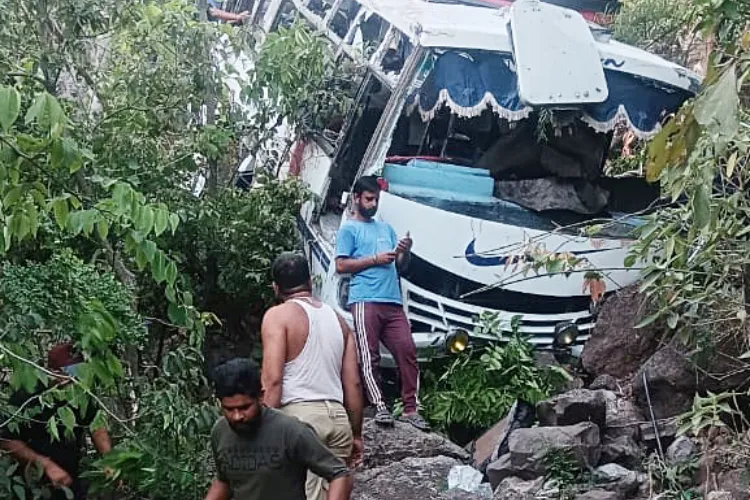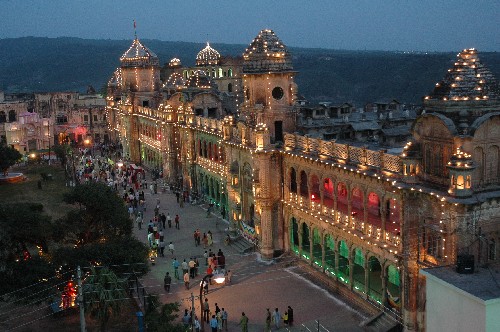.webp)
 Aasha Khosa/New Delhi
Aasha Khosa/New DelhiJammu, the other part of (Jammu and) Kashmir that rarely makes headlines, has gained the attention of the Narendra Modi government for its high vulnerability to terrorist attacks. In hindsight, one can feel bad that it came after nine pilgrims died in a terrorist attack on the bus that was carrying them and others from the cave shrine of Shiv Khori.
In no time, Home Minister Amit Shah called the heads of National security bodies and asked them to chalk out a plan to deal with the terrorists. After a five-hour huddle in Delhi, Shah declared that the Army and security forces would launch a Kashmir-type operation in Jammu.
As J&K emerged from the shadow of terrorism and political uncertainty with Article 370 given a burial and moved on the development track, the hinterland of Reasi also shed its anonymity. The world suddenly seemed to realise the importance of this serene mountainous district located beyond the Trikuta Hills of Vaishno Devi Shrine.
Reasi, carved out of Udhampur, is mostly mountainous and has picturesque valleys, rich cultural heritage, forts, and mighty Rivers like Chenab. More importantly, the Kashmir to Kanyakumari train is all set to chug through this region in a few months. Also, the World's highest railway bridge spans the Chenab River between two hills in Reasi.
Not too far from the bridge, The Geological Survey of India (GSI) had struck one of the world’s largest and purest Lithium deposits which is waiting to be excavated. Lithium is more than a goldmine as India is switching from fossil fuels to a solar power regime. This element is key to making cheaper solar batteries.
 The Ill-fated bus that was attacked by terrorists
The Ill-fated bus that was attacked by terroristsAnother important national asset located nearby is the 690-megawatt power project over the Chenab River. The run-of-the-mill project is one of the largest power projects in India that makes due use of water share from the three western rivers -Chenab, Jhelum, and Indus - flowing into Pakistan.
Under the Indus Water Treaty of 1960, India doesn't have full right of usage over these three rivers. Pakistan keeps an hawk's eye on all projects that India plans on these rivers. It even approached the International Court for Justice on the Bhagliar Dam (on Chenab River). It's another matter that Islamabad lost the case
It's there that the Pakistani terrorists had reached, lodged themselves in vantage positions, and gathered information about the movement of pilgrims who, lately have started extending their visit to the famous Vaishno Devi shrine to the lesser-known cave shrine of Shiv Khori at Pouni, 50 km from Katra. The plan was to stop the bus and kill pilgrims at gunpoint on a day when Prime Minister Narendra Modi was taking oath in Delhi for the third consecutive term.
It’s by providence that the driver who was hit by the bullet lost control; the bus fell into the gorge and the massacre was averted.
This also explains why alarm bells rang in Delhi after the Reasi attack while almost nothing happened when terrorists had attacked villagers and army convoys repeatedly in Rajouri-Poonch.
The Kashmir-type operations refer to counterinsurgency tactics that kept terrorists on the run despite an unlimited supply of arms -Kalashnikovs. RPGs, landmines, grenades, etc. - by Pakistan, hundreds of hideouts to stack them and hide terrorists at the time of cordon-and-search operations, and a big army of logistical managers (OGWs) who arranged food and safe passage for the terrorists in the Valley.
The relentless operations didn’t allow terrorists to hold onto territory. This is no small achievement given the fact the terrorists were well entrenched in Srinagar's thickly populated areas and the fact that urban insurgency is a nightmare for security forces to deal all over the world.
Today, the forces have the advantage of experience and technology due to which the counterinsurgency operations have become more targeted and precise. The difference is that while in Kashmir, insurgents were mostly locals and concentrated in the urban areas, in Jammu they are hiding in jungles. Also, now the Indian forces are mostly encountering mercenaries sent by Pakistan, who survive because of the strong logistical support from some locals, especially in the border areas.

The iconic Mubarak Mandi palace of Jammu
Jammu’s border belt and the vast forest area of Udhampur and Reasi will surely see a lot of combing operations in the coming days.
The major grievance of the local villagers like that of Dangri in Rajouri where Pakistani terrorists killed six members of a Hindu family including small children at close range, was that terrorists were being taken care of and guided by locals. This was proved when the police arrested a man from Rajouri who had guided the Reasi attacks for fees of Rs 6,000!
Under the Delhi plan, a holistic approach to tackling terrorism in Jammu would be implemented. Jammu seems much easier to tackle as it doesn't have the mass movement that Kashmir saw initially. However, it's challenging because of the infiltration of the highly trained and possibly ex-Army men from across the line of control. They are here to unleash violence and maybe have more diabolic plans up their sleeves.
With the situation in Kashmir changing after the abrogation of Article 370 and the mass movement for Azadi turning into a defunct idea, Pakistan has chosen Jammu for a low-intensity proxy war. By the textbook rule, Jammu with its mixed population of Hindus and Muslims is vulnerable to communal eruptions. However, the valiant people of the region have never fallen into this trap.
ALSO READ: Lithium village of Salal in J&K brimming with pride, hope and anxiety
Politically, Jammu is often ignored because of its peace-loving people who, despite their grievances, have rejected attempts by Pakistan-backed terrorists to communalize the situation. Dogra, as the people of Jammu region are called, are inheritors of martial traditions and a rich history. They have upheld peace and brotherhood under provocations and opened their hearts and homes to Kashmiris – Hindus initially and later Muslims too – who were fleeing their homes due to terrorism, violence and threats.
The author has reported Kashmir insurgency for a decade
